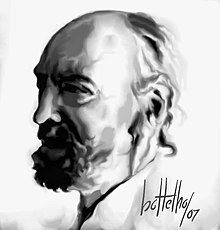Nadir Afonso
| Nadir Afonso | |
|---|---|
 |
|
| Born |
Nadir Afonso Rodrigues 4 December 1920 Chaves, Portugal |
| Died | 11 December 2013 (aged 93) Cascais, Portugal |
| Nationality | Portuguese |
| Education | École Nationale Supérieure des Beaux-Arts, Paris |
| Known for | Painting, Architecture |
| Notable work | Cities series |
| Movement | Geometric abstract art (also Kinetic art, Op art) |
| Awards | Order of St. James of the Sword, Portuguese Academy of Fine Arts |
| Patron(s) | Portinari, Vasarely, Léger, Auguste Herbin, André Bloc, Le Corbusier |
Nadir Afonso, GOSE (4 December 1920 – 11 December 2013) was a Portuguese geometric abstractionist painter. Formally trained in architecture, which he practiced early in his career with Le Corbusier and Oscar Niemeyer, Nadir Afonso later studied painting in Paris and became one of the pioneers of Kinetic art, working alongside Victor Vasarely, Fernand Léger, Auguste Herbin, and André Bloc.
As a theorist of his own geometry-based aesthetics, published in several books, Nadir Afonso defended the idea that art is purely objective and ruled by laws that treat art not as an act of imagination but of observation, perception, and form manipulation.
Nadir Afonso achieved international recognition early in his career and many of his works are in museums. His most famous works are the Cities series, which depict places all around the world. He was known to have painted into his later years and died on 11 December 2013 at a hospital in Cascais. During his life he achieved great honors, representing his country at the finest level.
Nadir Afonso Rodrigues was born in the rural, remote town of Chaves, Portugal, on December 4, 1920. His parents were Palmira Rodrigues Afonso and the poet Artur Maria Afonso. His very unusual first name was suggested by a gypsy to his father on his way to the Civil Registry, where he was due to be registered as Orlando.
By the age of four, he made his first "painting" on a wall at home: a perfect red circle, which anticipated his life as under the signs of rhythm and geometric precision. His teen years were dedicated to painting, and he won his first national prize at age 17. It was only natural that he was sent to the bigger city of Porto to enroll in the School of Fine Arts to pursue a degree in painting. However, at the registration desk, he took the advice of the clerk, who told him that his high school diploma allowed him to enroll in Architecture, which was then a more promising career. As he later admitted, he made a mistake by listening to that man.
...
Wikipedia
